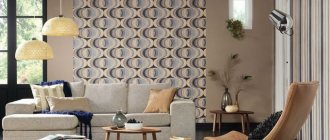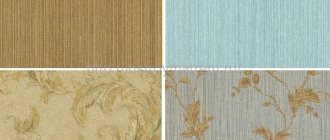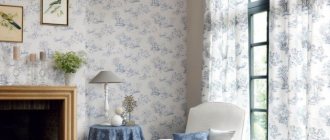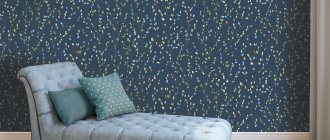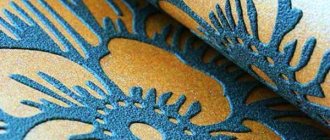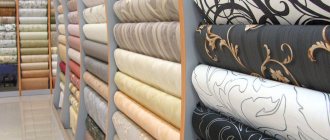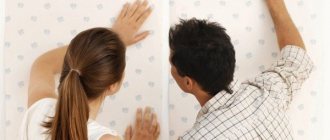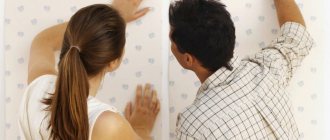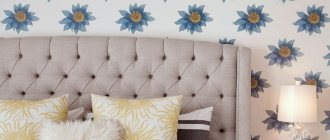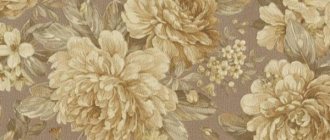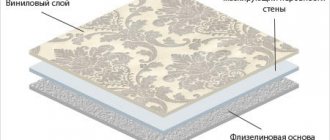The choice of material for finishing when carrying out work related to repairs is not a trivial task, so solving this issue requires allocating a large amount of time. With all the abundance of products of this type presented on the market nowadays, it will be difficult not to make a mistake with the choice.
When choosing vinyl wallpaper that will be in your room, you should take into account the climate created in the room. If real difficulties arise during the selection process, it is best to consult a professional.
Washable wallpaper - a great choice
Washable wallpaper is currently enjoying well-deserved popularity. Such material appeared not so long ago, but has already managed to occupy its own market niche. Greater resistance to fluctuations in temperature and very high humidity significantly expands the range of use of this type of wallpaper.
They can be used even in such non-standard premises, which include:
- kitchen;
- room with bathroom;
- living room;
- hall.
Washable wallpaper is distinguished by its variety of designs, textures and color solutions. This facing material consists of two layers. A PVC coating is applied to a paper or non-woven base. A drawing or pattern is implemented on top. This wallpaper contains antifungal elements, which greatly increase the overall service life of the product and prevent the formation of mold.
The polyvinyl chloride layer of washable wallpaper is able to resist contamination and a variety of mechanical damage. All this greatly simplifies the procedure for using the material, since to clean the coating you can wipe it with a wet napkin or cloth.
Introduction
Recently, manufacturers of building materials have been pampering us all with a huge selection of products that will help decorate an apartment and give it its own unique interior. The main place in the room, on which approximately 70% of the future design depends, are the walls. There are a variety of options here: the walls can be glued with wallpaper, covered with various paints and varnishes. In this article we will talk about non-woven wallpaper, and you will find out what “non-woven” is, what advantages and disadvantages it has.
Non-woven wallpaper
Image application technique
The new method of manufacturing washable wallpaper ensures that the finishing material used is distinguished by its very high strength and reliability of operation, as well as an acceptable service life. The front layer of the product can be decorated in a variety of ways. According to the manufacturing method, such wallpapers are divided into products made on the basis of structural vinyl with or without embossing.
Washable screen-printed wallpaper is made by applying vinyl paste to a paper backing. After which the material is subjected to thermal treatment in a specialized oven. In this case, instead of a filler, gas appears here. During its evaporation, the process of pore formation occurs.
Such a structure can guarantee the longest service life of the finishing material. With proper care, washable wallpaper will usually last at least fifteen years.
There is another variation of washable wallpaper, which is made using hot stamping. A paper blank with a printed pattern is placed in a specialized oven. Subsequently, processing takes place under the influence of high temperatures.
In this case, the front layer melts and is tightly embedded into the structure of the material. As a result, you can get different options for patterns and textures.
There are several different options for washable wallpaper, the decorative layer of which is applied using hot stamping. Moreover, the differences lie not only in the method of applying the image, but also in the final density of the material.
| Variation of material and method of drawing | Density, g/m2 | Individual characteristics |
| Silkscreen printing | 90-130 | Such wallpapers are distinguished by the smallest weight indicators. The applied PVC layer is also the smallest. The wallpaper surface is distinguished by its smoothness with a silk effect. |
| Compact vinyl | 150-200 | The material is much dense. Its characteristic feature is the ability to imitate textile or stone coating. |
| Heavy vinyl | From 250 | The densest material variation. The vinyl layer in this case will be as thick as possible. Such wallpapers are distinguished by their ribbed surface and the ability to smooth out the plane of the wall. |
Quite recently, another method was invented. We are talking about chemical embossing. Its meaning is that from the very beginning, specialized substances called inhibitors are applied to the paper base. They are directly responsible for creating the image on the surface of the wallpaper. The main feature of such substances is that they interfere with foaming.
When it enters the oven, the vinyl layer slowly foams and becomes larger in volume. But the areas with inhibitors remain constant. Ultimately, the applied pattern is distinguished by its extreme strength, as well as its resistance to direct sunlight and very high moisture. This variation of the material is simply perfect for finishing kitchens and bathrooms.
Paper and vinyl - a modern combination
Just 20 years ago, today's variety of wallpapers would have seemed fantastic. However, fantasy has become our reality, and today we have access to not just different colors and shades, but also wallpapers that are completely different in structure. Simple paper products are not that expensive and will always find their buyer.
After all, paper is an environmentally friendly material that does not interfere with air exchange through pasted surfaces. Therefore, you can safely use paper products to decorate any premises, including children’s rooms. But keep in mind that the humidity in them should not be higher than average. This budget option for tidying up rooms is used by many owners of old houses, especially since recently a large number of multi-colored wallpapers with raised patterns have appeared.
But, as a rule, such material does not withstand intensive use; repairs have to be done after 3–4 years. There is also a great danger that with high humidity, such wallpaper will begin to peel off and become moldy, and when exposed to sunlight, it will turn yellow and lose its original color.
Somewhat better in this regard is the duplex version of the products, in which two or more layers are combined - unlike single-layer ones, they are stronger, easily tolerate high humidity and ultraviolet rays, and, in addition, have a special protective layer. This wallpaper can even be wiped with a wet cloth. Typically, paper finishing is sold in 10-meter rolls with a width of 55–75 centimeters. In the price option, you can choose both inexpensive domestic and more expensive foreign options.
Vinyl non-woven wallpaper
To produce washable wallpaper, a classic paper or non-woven base can be used. In the latter version, the polyvinyl chloride mass is applied to a layer of non-woven fabric. This is the name of geotexil, for the production of which cellulose and textile fibers were used.
Some parts are connected to each other by a specialized connecting link. Non-woven fabric can give wallpaper different shapes, thanks to which we can talk about a wide choice of textures.
pros
Vinyl non-woven wallpaper has a wide range of positive qualities. Such material can hide all the small irregularities of the wall. Among other things, it stands out for its extreme ease of installation and subsequent operation.
During the pasting process, such wallpapers are not subject to deformation, so there are no particular difficulties in resolving this issue. This variation of the material can be used for wall decoration of rooms with very high levels of moisture.
Flaws
The main disadvantage of non-woven wallpaper is the high level of price indicators that characterize products of this type.
This state of affairs is caused by the fact that non-woven fabric is not manufactured on the territory of the Russian Federation, which makes it necessary to import this product.
Application nuances
Taking into account the fact that vinyl is designated as a synthetic-based coating, the question of its toxicity is not without its own popularity. Along with this, polyvinyl chloride is used very often today, so there is no need to be too afraid of the bad consequences of the material that is used.
The only thing you should pay attention to during purchase is the presence of a certificate confirming the good quality of the product. If the seller cannot provide it, then it is best to refuse this purchase.
Features of choice
Regardless of what kind of wallpaper will be used to decorate the walls, you must adhere to the basic rules for choosing them. First of all, you need to take into account such points as the degree of illumination of the room, its size and the purpose of the room.
It is better to cover small rooms with light-colored canvases, which allow you to visually enlarge the space. For rooms with low ceilings, options with vertical stripes are suitable, thanks to them it will be possible to visually raise the ceiling.
When choosing wallpaper, you also need to make sure that the room does not stand out from the overall design of the apartment. It is also necessary to take into account what kind of furniture will be in the room. The high-tech style does not go particularly well with classic wallpaper, and country style will not harmonize with the modern style.
Specifics of gluing non-woven wallpaper
The process of gluing walls using vinyl non-woven wallpaper should not be difficult. It is best to resolve this problem in stages. It is necessary to carefully approach the preparation of the wall plane.
Stage No. 1. Preparation of wallpaper
The first part of the preparation stage consists of the correct selection of wallpaper that will be used as a finishing material. You need to make all the appropriate measurements in advance and only then make the purchase. Before pasting, the wallpaper should be placed so that the applied pattern is intact.
Stage No. 2. Preparing the wall
The point of the second stage of the work is to prepare the wall plane. In this case, there may be a need to remove the covering, which is already outdated, if the repairs are not carried out in a newly purchased apartment.
At this stage, there may be a need to resolve these issues:
- Demolition of a coating that is already outdated.
- Removing irregularities.
- Putty.
- Surface priming.
- Drying before pasting.
It may be that it will be necessary to turn to the use of antifungal drugs, which can slightly increase the overall service life of the finishing material.
Stage No. 3. Wallpapering
After surface leveling, we proceed to the actual procedure of wallpapering the walls. The nature of the procedure is that the glue mixture is applied not to the material, but to the surface of the wall. For more reliable fixation, you can slightly blot the edges of the roll.
The adhesive solution is applied to the wall surface using a roller. It is best to work from window to door. It is necessary to take into account that such wallpapers have a fairly high stretch coefficient, due to which drying is accompanied by shrinkage of the material. In this context, you need to carefully approach the markup, making allowances for this property. The wallpaper should be leveled from top to bottom, and if the pattern is selected, from the middle to the edges.
Glue
Which glue is best for wallpaper
The durability of the repair and the appearance of the walls depend on which glue you choose for working with wallpaper. You should not try to glue thick vinyl wallpaper with glue for regular paper, it simply will not withstand the weight of the rolls. If you use glue for embossed textured wallpaper when working with light paper ones, then they will certainly stick. But it is possible that the wallpaper will have to be torn off from the wall along with the plaster during the next renovation.
There are universal adhesives suitable for all types of wallpaper. But experts advise choosing glue depending on the type of wallpaper.
Vinyl wallpaper adhesive needs to be thick, viscous, and with good adhesion. The following brands of vinyl wallpaper adhesives received the greatest number of positive ratings: Kleo Smart 5-6; Axton Vinyl; Metylan Vinyl; Quelyd Special Vinyl; Swedtex Vinyl.
These are starch-based adhesives. The cheapest of the above is Axton Vinyl, the most expensive is Swedtex Vinyl.
Vinyl wallpaper adhesive based on methylcellulose has a thick consistency; it is chosen for the densest and heaviest wallpaper. The top three look like this:
- Pufas Euro 3000 Special vinyl;
- Metylan Granulate Premium;
- Moment Vinyl.
Pufas is economical in consumption, Metylan is ideal for working with heavy textured wallpaper. Moment Vinyl is the most affordable.
Good ones for working with paper wallpaper: Moment classic; Metylan Universal Premium; CMC (carboxymethylcellulose); Quelyd-Express and Quelyd-Superexpress; Kleo Standard.
Each of them has its own characteristics: Moment Classic is suitable for one- and two-layer paper wallpapers, Metylan Universal Premium, Quelyd-Express and Quelyd-Superexpress dry quickly, Kleo Standard dilutes well and does not leave stains after drying. The cheapest option is CMC, which is also non-toxic.
- EXCLUSIVE NON WOVEN is especially good for textile wallpaper and silk-screen printing;
- Metylan Non-woven fabric is the most versatile, suitable for gluing lime and concrete surfaces;
- Quelyd Special non-woven fabric - does not react with paint, so this is the best option for wallpaper for painting.
The most expensive and high-quality is EXCLUSIVE NON WOVEN, the cheapest is Quelyd Special non-woven fabric.
When choosing glue, you must take into account:
- type of surface to be pasted;
- density and specificity of wallpaper;
- financial opportunities.
Wallpaper silkscreen
Paper base for wallpaper is the most popular option. Various coating options can be applied to it. The most common ones are shown below:
- textile;
- cork;
- vinyl;
- paper.
Two-layer paper-based wallpaper has many good qualities, and if vinyl is used as the front layer, the performance characteristics of the material will be even better. The scope of use of these wallpapers is also quite wide.
pros
Silk-screen wallpaper is very popular due to its high environmental friendliness, durability, and also due to its very low price indicators. Among other things, this variation of finishing material has sufficient air conductivity.
The free movement of air masses between the wall and the finishing material prevents the formation of mold and mildew. Paper wallpaper can be used without any particular concerns even in a child’s room or for covering walls in a bedroom.
Flaws
Among the bad qualities, it is necessary to note the low resistance of this wallpaper to very high humidity. Therefore, using this material for finishing work in a bathroom or kitchen will not be the right decision.
Among other things, the service life of silk-screen wallpaper is slightly lower than the variation of non-woven material.
What is non-woven fabric?
Nonwoven is a whole class of nonwoven materials based on cellulose. Strictly speaking, paper is also a type of non-woven fabric. The name itself comes from a registered trademark of a German company, and in Russian it is used as a common noun for paper-like materials.
Non-woven fabric is made from modified paper fibers with the addition of polyester and various specific additives. The liquid mass is pulled into a tape and compressed, if necessary, impregnated with adhesives. The composition of each individual brand of non-woven fabric is a manufacturer's secret, since added modifiers change the technical properties of the material.
Non-woven fabric has long been used as a backing for fabrics in the textile industry, in packaging and cushioning materials, and even in medicine. It is distinguished by the following properties:
- low moisture capacity;
- good breathability;
- no shrinkage when drying;
- greater abrasion and tensile strength than paper;
- fire resistance;
- good susceptibility to non-aqueous paints;
- the material practically does not wrinkle and easily restores its original shape;
- does not perceive pollution.
Thanks to these qualities, the material gained great popularity and began to be widely used as a substitute for paper - this is how non-woven wallpaper appeared.
putty
Rules for choosing putty
You need to choose putty for walls based on two criteria - composition and functions.
The composition of putty can be gypsum, cement and acrylic. Each material has its own characteristics. Gypsum putty is very plastic, allows you to level the surface well, does not shrink after drying, but is afraid of high humidity. Cement is resistant to moisture, but it takes a relatively long time to dry and shrinks slightly. Acrylic putty is the best option for finishing. It is petrol-shrinkable and quick-drying.
There are two types of wallpaper putty: starting and finishing. The starting one is intended for leveling large wall defects. It can be applied to concrete and brick bases. If it is necessary to eliminate serious surface defects, then it is permissible to apply several layers of the starting composition. The thickness of each layer can reach up to 10 mm, and each of them is reinforced with reinforcing mesh.
The finishing composition is designed to smooth out minor defects and make the surface smooth. The thickness of the applied layer does not exceed 2-3 mm, therefore it is not suitable for eliminating deep cracks and irregularities. There are also more expensive universal mixtures that simultaneously perform both of these functions.
It is better to buy finishing materials from one manufacturer.
Disadvantages in comparison
Price
Non-woven wallpaper is much more expensive than paper wallpaper. The cost is affected by the brand, the width of the roll, the applied relief and design. At the same time, they are quite affordable as wallpaper for painting.
Variety of patterns
Paper wallpapers are the most common and inexpensive products, so they are much more varied in color and pattern than non-woven ones.
Difficulty in gluing
Paper wallpaper is almost impossible to hang alone. Glue must be applied to the canvas, then lift the sheet to the ceiling and carefully iron along the entire length and width. It is necessary to ensure that it does not curl up or stick to everything. In this case, there is no need to apply glue to non-woven products.
Life time
Paper wallpapers deteriorate much faster, while non-woven ones last much longer. However, for example, in rooms where it is planned to regularly change the design (for example, in children's rooms - as children age, their artistic preferences change), it is more profitable to use paper products.
Price policy
Considering that vinyl wallpaper is an environmentally friendly product, their cost is appropriate. Usually their cost is 4-5 times higher than vinyl. This does not apply to non-woven wallpaper, which is covered with foam vinyl, which has the same properties as vinyl wallpaper, so there is no need to pay more just for the non-woven base. Due to the fact that non-woven wallpaper is very expensive, but at the same time is in great demand, you can often find counterfeits, so you should only buy the product from trusted suppliers.
Which ones to choose?
In the store, among the variety presented, you can get confused.
Decide exactly what functions of wallpaper are important in your case, what style you will give preference to in your home and how important the price factor is. If you are primarily interested in high-quality economy class wallpaper, then pay attention to Russian-made non-woven vinyl. Elite wallpaper can be selected from catalogs and in showrooms in large cities.
Price tags reach up to 100,000 rubles per roll. Coatings from German, Italian and even American manufacturers amaze the imagination with their majesty, brevity and high style. Some premium wallpaper manufacturers depict imitations of paintings by great artists of various eras on their products. To create coziness and chic in the interior at the same time, you can use wallpaper with a textile coating. They have high prices, but their appearance is excellent. Some fabric wallpapers are real works of design art.
Owners of playful pets with sharp claws should not be discouraged either. A modern development - non-woven products for painting, with an anti-vandal coating - this is what you need. Firstly, you decide what shade to give your walls, and over time you can easily change it. And secondly, the increased density in combination with a layer of paint will make anti-vandal wallpaper unusually durable and indestructible.
Plain wallpaper in light shades is suitable for the bedroom. If you want to achieve a bright accent, it is better to choose the wall behind the head of the bed: monograms, large curls, delicate flowers will be spectacular.
A wider range of colors would be appropriate in the living room. Trendy brick, concrete or stone wallpaper will stand out effectively in the loft style. The hall can be decorated with decorative panels with large geometric patterns or stripes.
It is better to choose washable wallpaper without natural coatings for the kitchen. Photo wallpaper will fit perfectly into the dining area. Cheerful landscapes or extraordinary images with one large object will create a mood and a unique design.
For tips on choosing non-woven wallpaper, see the following video.
How to visually and tactfully distinguish one from the other
How to distinguish non-woven wallpaper from vinyl wallpaper in a shopping center if there is no price tag nearby? It's simple - you can determine the type of trellis both visually and by touch. There are several ways to check the appearance of the wallpaper with your eyes only:
- look at the end of the tube - vinyl trellises are multi-layered, 2-3 layers of loose, thick material, non-woven fabric has one thin layer;
- tear off a small corner of the tube; in non-woven wallpaper the tear area is fibrous, in vinyl it is slightly jagged, without lint;
- study the back side of the wallpaper - non-woven fabric is always smooth, even if there is embossing on the front side, while vinyl with any backing repeats the embossing pattern (due to the method of applying the relief).
How can you tell by touch which wallpaper is which? Non-woven fabrics are velvety, pleasant to the touch, vinyl on the front side is cold and smooth in feel, despite the presence of embossing.
